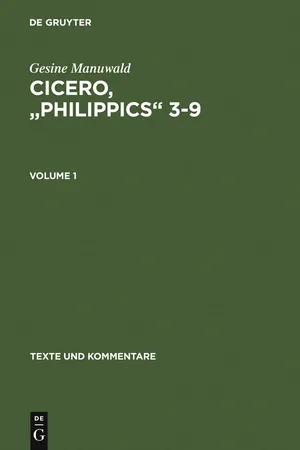
Cicero, "Philippics" 3-9
Edited with Introduction, Translation and Commentary. Volume 1: Introduction, Text and Translation, References and Indexes. Volume 2: Commentary
- 1,117 pages
- English
- PDF
- Available on iOS & Android
Cicero, "Philippics" 3-9
Edited with Introduction, Translation and Commentary. Volume 1: Introduction, Text and Translation, References and Indexes. Volume 2: Commentary
About this book
Mit den Philippischen Reden erreicht Cicero den abschließenden Höhepunkt seiner rhetorischen Leistung und politischen Tätigkeit. Diese vierzehn Reden sind ferner ein bedeutendes Zeugnis für die krisenhafte Endphase der römischen Republik. Trotzdem sind sie in der wissenschaftlichen Bearbeitung lange vernachlässigt worden. Die vorliegenden zwei Bände bieten nun einen umfassenden wissenschaftlichen Kommentar zu den Reden 3-9, sieben zentralen Reden des Corpus. Die detaillierte Kommentierung erschließt die Reden unter sprachlich, literarisch und historisch relevanten Aspekten (Bd. 2). Als Grundlage dienen ein neu durchgesehener lateinischer Text, eine englische Übersetzung sowie eine ausführliche Einleitung zu Problemen des gesamten Corpus; eine Bibliographie und Indizes vervollständigen die Ausgabe (Bd. 1). Über die durchgehende Einzelkommentierung hinaus wird der Charakter der Reden als rhetorische Konstrukte in der historischen Auseinandersetzung deutlich gemacht, weswegen ein Schwerpunkt der Analyse auf dem Nachweis der Argumentationstechniken und politischen Strategien Ciceros liegt. Der Aufbau des Kommentars zielt auch drauf ab, wissenschaftliche Informationen für Leser mit unterschiedlichen Interessen und Ausgangsvoraussetzungen bereitzustellen.
Frequently asked questions
- Essential is ideal for learners and professionals who enjoy exploring a wide range of subjects. Access the Essential Library with 800,000+ trusted titles and best-sellers across business, personal growth, and the humanities. Includes unlimited reading time and Standard Read Aloud voice.
- Complete: Perfect for advanced learners and researchers needing full, unrestricted access. Unlock 1.4M+ books across hundreds of subjects, including academic and specialized titles. The Complete Plan also includes advanced features like Premium Read Aloud and Research Assistant.
Please note we cannot support devices running on iOS 13 and Android 7 or earlier. Learn more about using the app.
Information
Table of contents
- Preface
- Note to readers
- Introduction to the Philippics
- 1. Previous scholarship and the present commentary
- 2. Historical background
- 2.1. Events in 44–43 BCE
- 2.2. People involved
- 3. The corpus of the Philippics
- 3.1. Title
- 3.2. Publication
- 3.3. Strategic elements
- 3.4. Rhetorical and stylistic aspects
- 3.5. Relevance of Demosthenes and Atticism
- 3.6. Relationship to contemporary Ciceronian works
- 3.7. Reception in antiquity
- Text and translation of Philippics 3–9
- 1. Note on text and translation
- 2. Orationes Philippicae/Philippics
- References and indexes
- 1. References and abbreviations
- 1.1. Editions, commentaires and translations of the Philippics
- 1.2. Editions and commentaires of other ancient works
- 1.3. Secondary literature
- 1.4. Dictionaires and reference works
- 2. Indexes
- 2.1. Persons
- 2.2. Sites
- 2.3. Subjects
- 3. Maps
- Commentary on Philippics 3-9
- 1. Philippic Three
- 1.1. Introduction
- 1.2. Outline of structure and contents
- 1.3. Select bibliography
- 1.4. Notes
- 2. Philippic Four
- 2.1. Introduction
- 2.2. Outline of structure and contents
- 2.3. Select bibliography
- 2.4. Notes
- 3. Philippic Five
- 3.1. Introduction
- 3.2. Outline of structure and contents
- 3.3. Select bibliography
- 3.4. Notes
- 4. Philippic Six
- 4.1. Introduction
- 4.2. Outline of structure and contents
- 4.3. Select bibliography
- 4.4. Notes
- 5. Philippic Seven
- 5.1. Introduction
- 5.2. Outline of structure and contents
- 5.3. Select bibliography
- 5.4. Notes
- 6. Philippic Eight
- 6.1. Introduction
- 6.2. Outline of structure and contents
- 6.3. Select bibliography
- 6.4. Notes
- 7. Philippic Nine
- 7.1. Introduction
- 7.2. Outline of structure and contents
- 7.3. Select bibliography
- 7.4. Notes